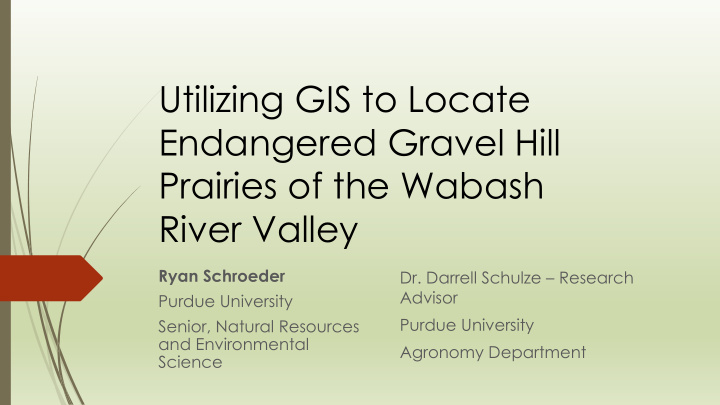



Utilizing GIS to Locate Endangered Gravel Hill Prairies of the Wabash River Valley Ryan Schroeder Dr. Darrell Schulze – Research Advisor Purdue University Purdue University Senior, Natural Resources and Environmental Agronomy Department Science
Background – Indiana Glaciation and Native Vegetation Wisconsinan glaciation Geomorphology mosaic – Wabash River Drainage Till plains, outwash terraces, kames, sand plains, etc Native Ecosystems Southern, central, northeastern Indiana – mesic forests Northwestern – prairie peninsula Wabash River Valley – forest, savannah, prairie mosaic Ecosystem of Interest – Gravel Hill Prairies (GHP) Xeric gravel bluffs, kames, terraces Eastern-most range of numerous mixed-grass prairie plants Soil & topographic position drivers of eastern extent
Rodman soil series: Sandy-skeletal, mixed, mesic Typic Hapludolls
Significance & Research Goals Indiana gravel hill prairies – state endangered ecosystem Community similar to prairies farther west Seven state endangered plant species Post, Bacone, and Aldrich (1984) Located 4 remnants ~5ha total Managed by TNC, NICHES Land Trust, IDNR Plant community nearly extirpated Lack of natural disturbance Development & Gravel Mining Goal – locate unknown remnants GIS spatial analysis – suitability modeling
western rock jasmine Pitcher’s stiltwort aromatic aster prairie-rocket wall flower plains muhlenbergia kittentails narrow-leaved stoneseed
Methods – Spatial Analysis ArcGIS v10.3 (ESRI) Data NRCS gSSURGO dataset County DEM data Aerial Imagery Habitat Suitability Model Isolated Rodman series Suitable =157 – 293 o Aerial Image Analysis Delineate AOI’s
Methods – Field Scouting Collaborators The Nature Conservancy NICHES Land Trust Focused on Tippecanoe Co. Visited accessible sites Develop plant list Goal: find endangered species
Results Total area of Rodman soils in Indiana = 10,016 ha Analyzed Tippecanoe & Fountain Co.’s GIS Results Rodman Soils Suitable Area Areas of Interest County Suitable area (% of total) (hectares) (hectares) (Locations | Hectares) Tippecanoe 4,430 1,354 31 550 46.46 Fountain 2,163 813 38 259 64 Total AOI’s Delineated: 809 AOI’s scouted: 47 – primarily in Tippecanoe Co. Unknown remnants located: 5 One with aromatic aster Four with characteristic dry-mesic/xeric indicator vegetation Range of plant community degradation Numerous high-quality natural oak woodlands located
aromatic aster Additional Species Present big bluestem • bee balm • silky wild rye • woodland sunflower • wild petunia • flowering spurge • fragrant sumac • columbine • hairy penstemon • prickly pear •
Significance & Future Work Located unknown remnants - one w/ endangered species Despite degradation – remnant still present Model effectiveness – GHP’s not guaranteed Numerous high-quality natural areas (open-oak woodlands) found Learning process – aerial image interpretation Conservation organizations (TNC, NICHES, DNR) involved Reaching out to landowners Starting conservation process 35% of Indiana Rodman soils yet to be analyzed
Questions? Acknowledgements: Dr. Songlin Fei, Derek Luchik, Gus Nyberg, Bob Easter, Brad Wiegel
Recommend
More recommend